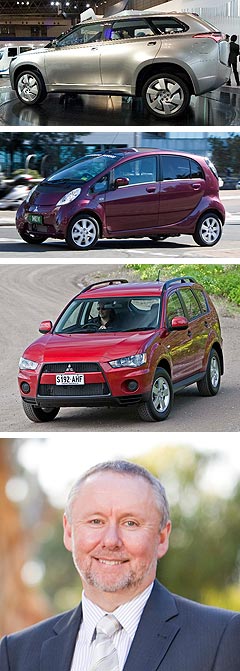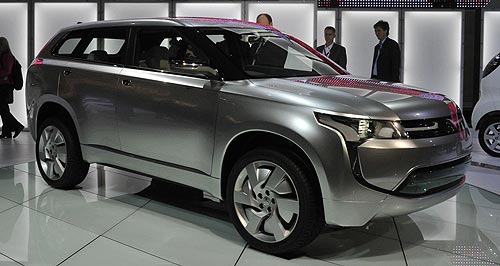Future models - Mitsubishi - PX-MiEVMitsubishi set to switch on second-gen EV technologyFrom concept to reality: Mitsubishi’s first hybrid SUV will be based on the PX-MiEV concept (pictured) and is likely to be launched here as part of the Outlander range. Plug-in ‘Outlander’ SUV likely to get benefits of latest Mitsubishi EV developments3 Dec 2010 AUSTRALIA’S first plug-in hybrid SUV – due from Mitsubishi by 2013 – will boast the pioneering company’s second-generation electric vehicle technology that is likely to include batteries that are faster to re-charge and probably cheaper. As well, Mitsubishi’s full-electric i-MiEV city car is set to get an upgrade by the time it goes mainstream in the second half of 2011, when the general public will at last be able to buy one of the pioneering city cars off the showroom floor. Mitsubishi’s first hybrid SUV – based on the company’s PX-MiEV concept first shown at the 2009 Tokyo motor show and most likely to be launched here as part of the Outlander range – will be just the first Mitsubishi four-wheel drive to be powered by Mitsubishi’s EV systems as the company attacks the ‘environmental vandal’ stigma attached to off-roaders while at the same time satisfying Australian drivers’ demands for practical large vehicles with greater efficiency.  From top: Mitsubishi PX-MiEV, Mitsubishi i-MiEV, Mitsubishi Outlander, MMAL vice president of corporate strategy Paul Stevenson. From top: Mitsubishi PX-MiEV, Mitsubishi i-MiEV, Mitsubishi Outlander, MMAL vice president of corporate strategy Paul Stevenson.The concept PX-MiEV is said to be capable of driving up to 50km on a single charge of its lithium-ion batteries via twin electric motors before the 85kW 1.6-litre petrol engine kicks in. The vehicle generally drives through the front wheels via an electric motor fitted to the front powertrain, but switches into all-wheel-drive mode by powering up a rear-axle electric motor when wheel-slip is detected. At higher speeds, the petrol engine also helps to drive the front wheels directly, while the rear electric motor can kick in to provide a measure of stability control and rapid acceleration. Mitsubishi Motors Australia Limited (MMAL) plans to have its second-generation EVs on the market around the time the plug-in SUV hits the showrooms in about 2012-13, when, it says, its rivals are introducing their first-generation EVs into Australia. MMAL vice president of corporate strategy Paul Stevenson said this week that billions of dollars were being poured into battery research and production facilities globally, with exciting developments being reported by researchers. He said that as battery technology improved, it would be applied to more all-electric Mitsubishi models. “As an interim stage, we will be going to more plug-in hybrids until the range of batteries is viable for everything under the sun,” he said. Mr Stevenson said the first of these would be a plug-in SUV that would be similar in concept to the PX-MiEV. “The key point is you get to drive it during the week as your daily commute in pure EV mode, and if you go heading off on the weekends using your four-wheel drive or driving longer distances, the charger kicks up in the back and charges it up,” he said. Mr Stevenson said such vehicles would help to restore the lifestyle element to motoring which he said had been lost in the electric vehicle debate. “At present, everyone has it in their heads that we have to drive towards smaller cars, for the environment and all of that,” he said. “That means for Australians in particular we are asking them to make lifestyle changes, because we like bigger cars – we like SUVs etc. “But with plug-hybrid and EV technology, it that doesn’t matter what size car you want – you can have an electric or plug-in hybrid Outlander or a Pajero. “While you are driving it around in electric mode, recharging if from renewable sources, it is completely clean. “Hopefully in five or six or seven years SUV owners won’t be the ‘environmental vandals’ that some people like to make them out to be. That just chops that off straight away.” Mr Stevenson said Mitsubishi’s long-term strategy this decade was to offer EV powertrain choice as a matter of course. “We walk into a dealership and say ‘what do you want to get? Outlander. OK what do you want – diesel, petrol or plug-in hybrid?’ So it will just be a powertrain option virtually on any new model.” Mitsubishi’s first plug-in hybrid SUV – known in industry jargon as a range-extender vehicle – may not be the first plug-in hybrid vehicle on the market, with Holden’s Volt set to lob in 2012. However, Mitsubishi looks set to become the first major car-maker to offer an EV for open sale, with stocks of i-MiEV customer cars to arrive in the second half of 2011. Currently, the 112 i-MiEVs registered in Australia – 80 of which arrived in October – are in the hands of either state and federal governments or fleets in field trials under a lease arrangement. The four-seat i-MiEV – which will also be sold in Europe as the Peugeot iOn and Citroen C-Zero – has a range of up to 160km, depending on driving conditions and speed, driving through the rear wheels via a 47kW/180Nm electric motor. MMAL has hinted that the final production model will get some improvements, but it is not saying what, and nor has it disclosed how much the car will cost or how many it expects to sell. “We are working on that right now,” Mr Stevenson said. “It is a difficult equation – electric vehicles and pricing. “It is like any new technology – when it first comes out it is expensive and it is a matter of driving it down and the fastest way to drive it down is those economies of scale.” On the timing of the saleable i-MiEV, Mr Stevenson said: “Obviously we will want to make an announcement on that fairly soon.” Mitsubishi insiders say i-MiEV sales are likely to start in the second half of 2011, with a target price of about $60,000 to $65,000. But volumes are still expected to be restricted due to a shortage of batteries. Mr Stevenson said manufacturers were tripling battery production volumes each year, but demand still out-stripped supply. “We have supply side constraints at the moment – Mitsubishi can’t supply enough of them,” he said. “Not so much the cars but the batteries.” MMAL president and CEO Masahiko Takahashi said battery researchers had three development goals for car batteries – lower cost, greater driving range and faster charging. He said the latter was seen to be a priority for the second generation of battery research, while lower cost would be a function of greater production volumes and economies of scale. Mr Takahashi said Mitsubishi was likely to pick up faster charging in its second-generation batteries and perhaps reduced cost due to the rapid expansion of EV production.  Read more15th of October 2010  Sydney show: Mitsubishi injects Sport into i-MiEVMitsubishi powers up its pioneering electric car with the i-MiEV Sport concept5th of August 2010  Mitsubishi to ship 70 more i-MiEVs to OzAustralian SOS for more Mitsubishi EVs granted as pioneering first 20 arrive26th of July 2010  More i-MiEVs on the wayMitsubishi Oz to lobby parent company for more i-MiEVs this year and next20th of July 2010  Fleets switch on to Mitsubishi EVFirst Mitsubishi i-MiEVs destined for 33 government and corporate organisationsAll future models Alfa Romeo Alfa Romeo Abarth Abarth Audi Audi Aston Martin Aston Martin BMW BMW Bentley Bentley Chrysler Chrysler Chevrolet Chevrolet Dodge Dodge Citroen Citroen Ferrari Ferrari DS DS Ford Ford Fiat Fiat FPV FPV Foton Foton Haval Haval Great Wall Great Wall Honda Honda Holden Holden Hyundai Hyundai HSV HSV Isuzu Isuzu Infiniti Infiniti Jeep Jeep Jaguar Jaguar Lamborghini Lamborghini Kia Kia Lexus Lexus Land Rover Land Rover Mazda Mazda Maserati Maserati Mercedes-Benz Mercedes-Benz McLaren McLaren Mini Mini Nissan Nissan Mitsubishi Mitsubishi Peugeot Peugeot Opel Opel Proton Proton Porsche Porsche Renault Renault Ram Ram Saab Saab Rolls-Royce Rolls-Royce Smart Smart Skoda Skoda Subaru Subaru SsangYong SsangYong Tesla Tesla Suzuki Suzuki Toyota Toyota Volvo VolvoMotor industry news |
Click to shareMitsubishi modelsResearch Mitsubishi All future models Alfa Romeo Alfa Romeo Abarth Abarth Audi Audi Aston Martin Aston Martin BMW BMW Bentley Bentley Chrysler Chrysler Chevrolet Chevrolet Dodge Dodge Citroen Citroen Ferrari Ferrari DS DS Ford Ford Fiat Fiat FPV FPV Foton Foton Haval Haval Great Wall Great Wall Honda Honda Holden Holden Hyundai Hyundai HSV HSV Isuzu Isuzu Infiniti Infiniti Jeep Jeep Jaguar Jaguar Lamborghini Lamborghini Kia Kia Lexus Lexus Land Rover Land Rover Mazda Mazda Maserati Maserati Mercedes-Benz Mercedes-Benz McLaren McLaren Mini Mini Nissan Nissan Mitsubishi Mitsubishi Peugeot Peugeot Opel Opel Proton Proton Porsche Porsche Renault Renault Ram Ram Saab Saab Rolls-Royce Rolls-Royce Smart Smart Skoda Skoda Subaru Subaru SsangYong SsangYong Tesla Tesla Suzuki Suzuki Toyota Toyota Volvo VolvoMotor industry news |















Facebook Twitter Instagram